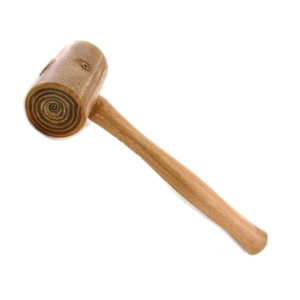Rawhide Mallet: Difference between revisions
From DT Online
mNo edit summary |
mNo edit summary |
||
| Line 10: | Line 10: | ||
=====Features and Uses===== | =====Features and Uses===== | ||
They are commonly used by [https://en.wikipedia.org/wiki/Silversmith '''Silversmiths'''] and [https://en.wikipedia.org/wiki/Coppersmith '''Coppersmiths'''] to form sheet metal over '''[[ | They are commonly used by [https://en.wikipedia.org/wiki/Silversmith '''Silversmiths'''] and [https://en.wikipedia.org/wiki/Coppersmith '''Coppersmiths'''] to form sheet metal over '''[[:Category:Stakes|Stakes]]'''. | ||
Latest revision as of 15:33, 11 May 2017
Description
Rawhide Mallets have a head made from rolled up leather.
Features and Uses
They are commonly used by Silversmiths and Coppersmiths to form sheet metal over Stakes.
- Traditional Boxwood Mallets are now largely superceded by Nylon, PVC or rubber faced hammers and mallets for general work. They are available in a range of diameters and weights.
- Carpenters' Mallets with a head size of 4-5 inches (100mm - 125mm) are a suitable size for most work in Design and Technology.
- Carving Mallet heads are commonly made from Beech but Lignum Vitea heads are considered better because they are heavier. They may now be hard to find. A modern alternative is to use Polyurethane for the heads (Bronze or Brass also used). A good general size head weight for light work would be approximately 450 grams or less, and for general work, 800 grams is more suitable.
- Bossing Mallets are sized by head diameter (35, 50, 60, or 75mm). The smaller sizes are used for art metalwork and the larger sizes are for shaping and stretching sheet metal and soft roofing materials such as lead.
 |
 |
 |
 |
 |
| Nylon Hammer |
Rubber Mallet |
Carpenters Mallet |
Carvers Mallet |
Rawhide Mallet |
